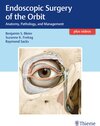
×
![Buchcover ISBN 9781626235069]()
Endoscopic Surgery of the Orbit
Anatomy, Pathology, and Management
von Benjamin S. Bleier, Suzanne K. Freitag und Raymond SacksThe benchmark reference on endoscopic surgery of the orbit from international experts! The use of endoscopic orbital surgery is rapidly expanding in modern day rhinology and oculoplastic practice. In the past two decades, endoscopic techniques have been adapted for lacrimal and orbital surgery. Significant advances have been made in endoscopic endonasal and periocular approaches to the orbital apex and skull base, especially in the last 3 years. There has been no book dedicated to these recent surgical innovations until Endoscopic Surgery of the Orbit: Anatomy, Pathology, and Management by Benjamin Bleier, Suzanne Freitag, and Raymond Sacks filled this void. This landmark text and its accompanying videos bring together the global experience of thought leaders and pioneers with multidisciplinary backgrounds. The collective expertise shared throughout 20 chapters codifies the current state of endoscopic orbital surgery and sets the stage for future developments. The opening chapters cover anatomy, physiology, and radiologic aspects pertaining to the orbit, paranasal sinuses, and surrounding structures. Subsequent chapters detail evaluation and endoscopic management of a full spectrum of pathologies utilizing orbital and optic nerve decompression, reconstruction, transorbital approaches, and anesthetic techniques. Key FeaturesState-of-the-art evidence-based medicine including the pros and cons of different treatment approachesManagement of operative complications such as sinusitis and iatrogenic intraorbital injury, and postoperative challengesPathology-specific topics including congenital and acquired lacrimal obstruction, thyroid-related eye disease, trauma, orbital neoplasms, and skull-base neoplasms with orbital involvement138 original illustrations help elucidate complex anatomyHigh definition, narrated surgical videos delineate specific surgical techniq




